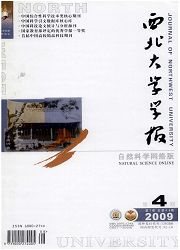

 中文摘要:
中文摘要:
目的研究姜黄素与铁(Ⅲ)的络舍反应,并建立铁的测定方法。方法采用分光光度法。结果在10^-5~10^3moL/L范围内,姜黄素有不同的吸收光谱;其与铁络合物的吸收波长由430nm红移至496nm,呈增色反应。在pH5.60,浓度为6.51×10^-4mol/L姜黄素液中,络合物为酒红色,λmax=496nm,ε=3.86×10^4L/mol·cm,铁(Ⅲ)的线性范围为0.20—2.00μg/mL。结论在较高浓度下自动聚合的姜黄素与铁(Ⅲ)反应更灵敏。在此基础上,建立的姜黄素测定铁的分光光度法操作简单,选择性较好,灵敏度高,用于自来水中铁(Ⅲ)的测定,结果满意。
 英文摘要:
英文摘要:
Aim To study the curcumin's complex reaction with Fe (Ⅲ) and develop a spectrophotometric method of determination of Iron (Ⅲ). Methods Spectrophotometry was used. Results In the range of 10^ -5 - 10^-3 mol/ L, curcumin had different absorption spectrograms. The absorption wavelength of the curcumin-Fe (Ⅲ) complex was red shift from 430 nm to 496 nm and its absorbance increased. In the pH 5.6 solution containing 6. 51 ^ 10 ^-4 mol/L curcumin, the complex is claret-red and the molar absorptivity is 3.86 × 10^4 L/mol · cm at λmax = 496 rim. The calibration curve is linear in the range 0. 20 - 2. 00 μg/mL for Fe (Ⅲ). Conclusion At the higher concentration, polymerized curcumin is more sensitive to react with Fe (Ⅲ). Based on this, a simple, selective and sensitive spectrophotometric method has been developed and applied satisfactorily to determine Fe( Ⅲ) in tap water.
 同期刊论文项目
同期刊论文项目
 同项目期刊论文
同项目期刊论文
 Observation of nicotinic acid in nicorandil samples and simultaneous determination of nicorandil and
Observation of nicotinic acid in nicorandil samples and simultaneous determination of nicorandil and Determination of puerarin in pharmaceutical injection by flow injection analysis with acidic potassi
Determination of puerarin in pharmaceutical injection by flow injection analysis with acidic potassi Application of multivariate curve resolution-alternating least square methods on the resolution of o
Application of multivariate curve resolution-alternating least square methods on the resolution of o Sensitive determination of nanogram levels of diacerein in a pharmaceutical formulation by flow inje
Sensitive determination of nanogram levels of diacerein in a pharmaceutical formulation by flow inje Application of multivariate curve resolution-alternating least square on analysis of hyphenated-inst
Application of multivariate curve resolution-alternating least square on analysis of hyphenated-inst 期刊信息
期刊信息
